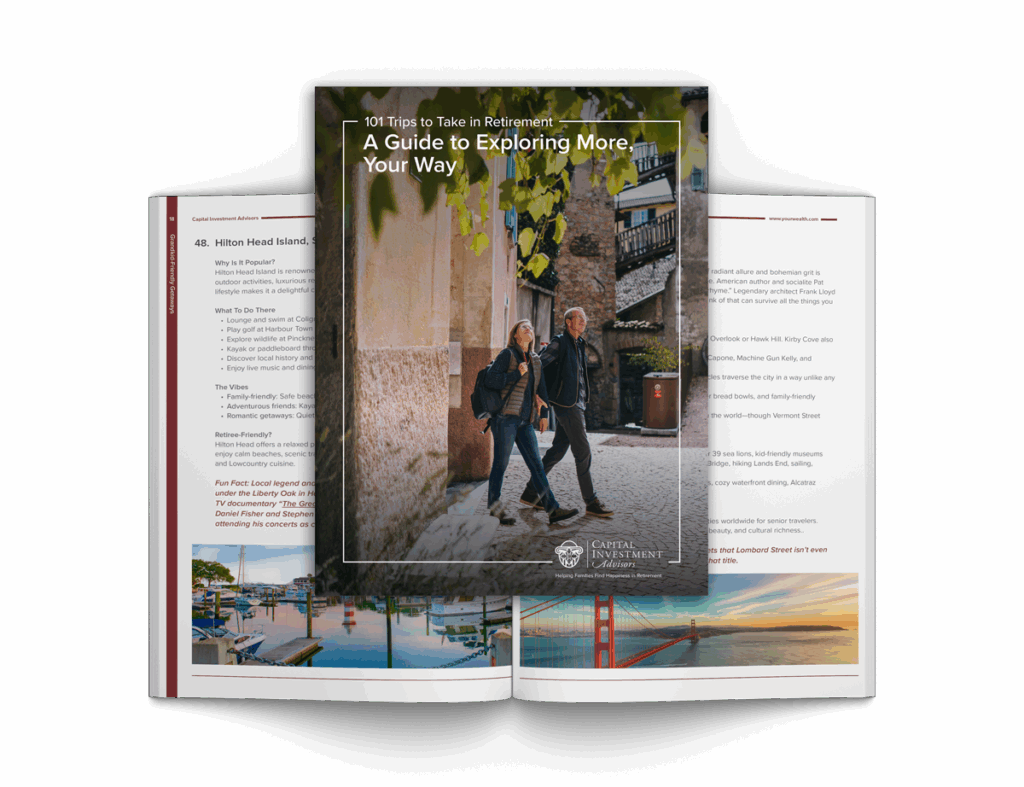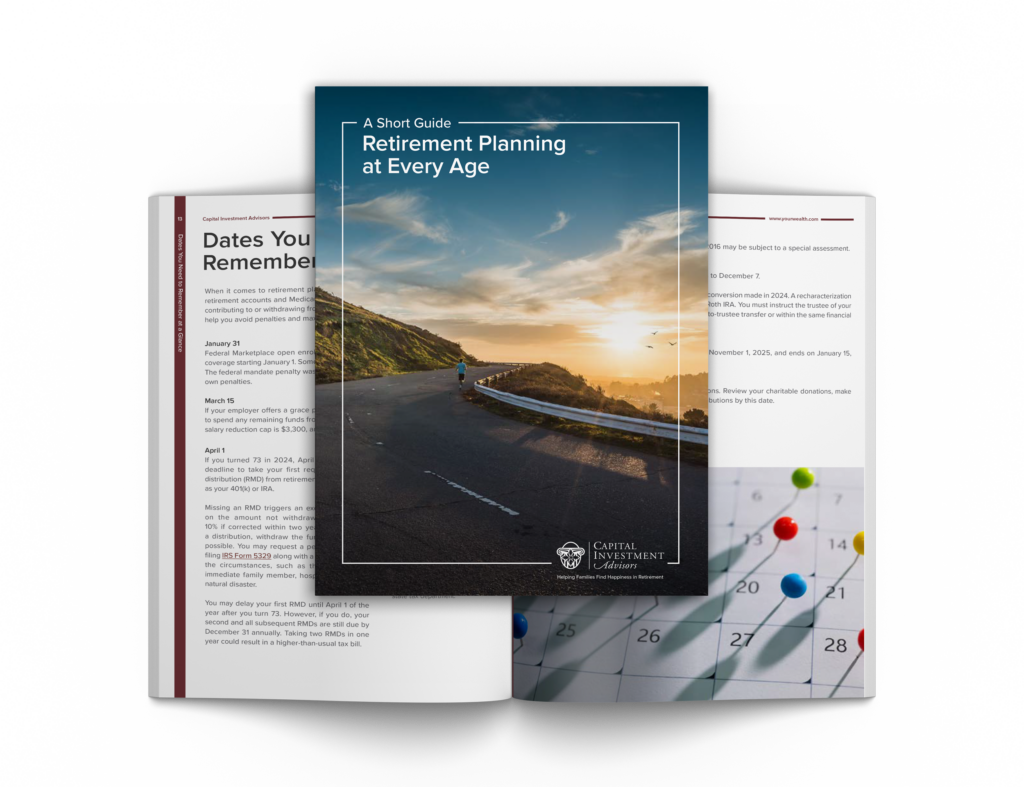Dive into this episode for practical insights, updated research, and actionable retirement anecdotes. 🚀
Wes Moss and Connor Miller cut out the financial jargon and help you jumpstart your strategy. Discover:
-
Groundbreaking new findings from the Money and Happiness in America study—including how much liquid savings may land you in the “green zone” of retirement happiness.
-
The evolving benchmarks for financial comfort and the plateau effect of wealth on happiness.
-
Why uncontrollable economic circumstances often top retirees’ list of worries.
-
How geopolitical events and oil prices could intertwine with retirement planning
-
Surprising stats about the happiness levels of Americans near retirement and why simply reaching retirement might boost happiness dramatically.
-
The persistent “fear of running out of money”—even among high-net-worth individuals.
-
A look at today’s tough job market for recent college grads and the impact of AI.
-
The widening gap between market optimism among Republicans and Democrats.
-
What history says: Staying invested usually beats trying to time the market based on politics.
-
Free new ebook guide for retirement planning by decade, available Here.
🎧 Listen now to stay ahead of the headlines—and start building a happy retirement.
Read The Full Transcript From This Episode
(click below to expand and read the full interview)
- Wes Moss [00:00:02]:
The Q ratio, average convergence, divergence, basis points and BS Financial shows. Love to sound smart, but on Money Matters we want to make you smart. That’s why the goal is to keep you informed and empowered. Our focus providing clear, actionable information without the financial jargon to help 1 million families retire sooner and happier, bigger. Based on the long running WSB radio show, this Money Matters podcast is tailor made for both modern retirees and those still in the planning stages. Join us in this exciting new chapter and let’s journey toward a financially secure and joyful retirement together. Co host Connor Miller in studio Always.Connor Miller [00:00:50]:
Great to be on with you on a Sunday morning.Wes Moss [00:00:52]:
You and I have been doing a ton of data analysis over the last week that’s not meant to put our listeners to sleep.Connor Miller [00:00:58]:
Leap.Wes Moss [00:01:00]:
Believe me, you’re going to want to hear this because we have some really, I would say massively updated and evolved data from our recent Money and Happiness in America study that we’ve taken took a couple months to do and it’s taken a couple months to really dig into the data and understand the data. Maybe a bigger project this time around kind of than we did when we did this 15 years ago. But it’s I don’t remember it taking this long. Is it because we had a much larger survey?Connor Miller [00:01:28]:
We just have so much more data this go around and I think it’s going to produce even better results than the last time.Wes Moss [00:01:33]:
Yeah, better as in just more telling results and more prescriptive results in that. What does our theme here on Money Matters for the last 15 plus years in addition to income investing, which we’re giant believers in and have been and continue to be and actually there’s a great story this week, the Wall Street Journal about yields and how it’s interesting that we’ve had a convergence of yield with pretty much every asset class, everything yields kind of the same. As the title of the article is, the stock market earnings multiple is about the or the inverse of the earnings multiple is similar to what corporate bonds are, which are similar to what treasury bonds are, which is similar to almost anywhere you look. So that’s interesting and I like that story. Not as a bad thing, but I think it’s a good opportunity for income investors because we can get some yield from multiple areas at and there’s not a huge amount of divergence. I don’t see that as a bad thing provided there is some yield and there really is.Connor Miller [00:02:37]:
And again, a massive shift from where we were 3, 4, 5, 10 years ago.Wes Moss [00:02:43]:
Bonds were yielding practically nothing.Connor Miller [00:02:45]:
We’ve talked about it before, Tina. There is no alternative to stocks because bonds weren’t yielding anything.Wes Moss [00:02:51]:
If only gold paid a dividend, wouldn’t that be great? Wouldn’t that be great? Then everything would have a nice yield. So going back to the theme of money matters has been how do we get to retirement a little sooner? Our podcast is named the Retire Sooner Podcast. So then we do troves of research around the habits of happy versus unhappy retirees. And those prescriptions to be a happy retiree often lead to financial freedom a little earlier, hence retire sooner. So it all converges, if you will. But the numbers have changed a lot. I’d say the foundation of our data is very much intact and it’s very similar to what it was 15 years ago and throughout these years. But the habits have evolved and the finances have evolved pretty significantly because, again, it’s been a decade and a half.Wes Moss [00:03:42]:
And we’re going to unveil some of those numbers here today on this edition of Money Matters. But we’ll probably have to say this over and over and over again for the next couple of years because we’ve been citing numbers from our initial really two studies. And the world has just changed. I mean, we’ve had multiple presidents, multiple White House occupants since we did this. We’ve had a global pandemic. We’ve had mired in multiple wars around the country, and we had a bout of inflation post Covid that was reminiscent of the 1970s. So a lot has changed. The housing market’s in a very different place today.Wes Moss [00:04:20]:
So there’s been a real evolution of the finances behind what I would call the happy retiree, almost as though if we were doing a National Geographic special sitting there with a camera long, far away, the happy retiree, what do they do today? So I wanted to start with that because that is something we’ll continue to talk about over time. But the money and happiness chart, which is kind of the foundation, maybe I’ll start with two things and we’ll do two elements here and we’ll start with the maybe a third or fourth element, which reminds me of what’s happening in the Middle east right now. So again we have Israel and Iran in this, again, a conflict that is now bubbled up and bubbled over again. So it’s nothing new that we have massive unrest in the Middle east and we’re here again today with, with that back on the table. But it is no wonder that the number one worry we asked about what makes you happy in retirement and what makes you what makes you worry in retirement? And the number one. And it’s virtual. This is a virtual tie. But statistically is a greater emphasis on the number one worry.Wes Moss [00:05:33]:
Again, it’s not health up there is almost number one. You would think it would be number one. It is the worry of uncontrollable economic circumstances like inflation and the stock market and running out of money. And those converge as the primary drivers of what people are scared about and worry about in retirement. And there’s not a week we come in here on a Sunday that we’re not in the middle of something new, and we’re again in the middle of something new that’s not so new. Just because we have conflict around the world over and over and over again, it never seems to really get solved. Even if it seems like it’s solved, it bubbles back up. And here we are again today.Connor Miller [00:06:14]:
Yeah. And again, not to diminish the human tragedy of geopolitical conflict and war. I mean, that is very present. But the first natural reaction you have is, well, how does this impact my finances? How is this going to impact the markets? How is this going to impact the economy? How will this impact oil and the cost of energy? And so all those things are very natural reactions that we have as investors.Wes Moss [00:06:40]:
And I think your point around oil is that even though we are completely oil independent here in the United States, we have all the oil we need, but it doesn’t mean that the price doesn’t get impacted when there is. There’s supply shortages, disruptions around the world.Connor Miller [00:06:57]:
Right? Yeah. So we have enough oil to satisfy our energy needs, but there’s still a lot of oil that comes from that. That region, Iran being one, Saudi Arabia, all of the countries that surround the Persian Gulf. I think the numbers are about 25, 20. Call it 20 to 30% of all oil shipped globally comes from that region of the world.Wes Moss [00:07:20]:
So instability there means instability when it comes to oil prices. And that’s something we’ll be talking about now, who knows for how long, but it’s obviously back on the table. And it is no wonder that the primary worry of retirees in general, this isn’t just happy versus unhappy, this is America. I’m worried about uncontrollable economic circumstances, market volatility, and again, the worry, the fear of running out of money, which is separate, but it’s still on the list of the top three. So a couple of things as we get to our new money and happiness data. So how much money does it take to have a sense of comfort, peace, of mind, clarity. And what does it look like for someone in America that says that they are in a happy state of life? And there’s two things we’ll look at. One, we look at the propensity of happiness just in general.Wes Moss [00:08:13]:
And this is, I think it’s pretty Good news. About 3/4 of America report. Not quite, but let’s call it. Almost three quarters of Americans report that they are in a, in a happy phase of life. These are those who are close to retirement age or in retirement. Now. There’s some big differences, though, when it comes to looking at these populations, saying, okay, well, what does it take to be happy from a money perspective? And there’s for a lot of years. One of the very interesting data points that we found 15 years ago was that the, we needed to reach $500,000 in America to start to feel and go over to the, from the unhappy to the happy group.Wes Moss [00:08:55]:
Unhappy retirees versus happy. It’s not a surprise that number’s higher today. But we look at it with a slightly more nuanced eye today because it’s not just a happy or unhappy. Here’s this checkpoint, which was good at the time, Connor. But that’s, that’s, that’s back when we were just getting started. Now we’ve evolved a little bit and we look at this now, and the data’s come back to show really three different zones. Call it just the traffic light zones. We’ve got the red zone you don’t want to live in.Wes Moss [00:09:25]:
We have the yellow zone, which is, okay, not Alcatraz, but it’s also not huge levels of happiness higher. And then we have this green zone where we see happiness levels that are significantly higher than the baseline population of our data. So think of it as I’m describing this. Think of a chart with the bottom access the categories of how much investable assets we have saved. So first category is $100,000 or less. Next category is 100 to 5. Really 100 to 500 to 500 to just under a million and then a million. The next zone, million to 2.9 million and 3 million plus.Connor Miller [00:10:05]:
And, and a way to think of this in investment terms or in the investment world, we call this alpha. Right. How well do you stack up relative to a benchmark? Benchmark does 10% and I do 12.Wes Moss [00:10:16]:
Doing pretty good.Connor Miller [00:10:17]:
2% alpha above the benchmark. That’s how we’re thinking about this in terms of happiness relative to how much you have in investable assets.Wes Moss [00:10:24]:
And this was a great epiphany as we were going through this data, we’re like why do we present this? And we came back to this thought this was your idea around wait a minute, it’s if having this much money gives us some happiness alpha and I don’t know if I’ll call it that in the book, in the white paper because that’s a very much a financial term and we’re talking about something that’s non financial. We’re talking about happiness. But it is the idea of if we get to these certain financial levels, something happens to our psyche and we have a higher probability of landing in the happy versus unhappy camp. So here are the categories. So in the red category which shows a 23% less than normal baseline happiness. So these are this, this population with 100,000 or less has a significant level of unhappiness involved in that group. And of course you can, you can come up with the reasons you want. I think common sense just says there’s not a lot of cushion there, not a lot of financial security, high worry, running out of money.Wes Moss [00:11:24]:
So there’s a lot of anxiety in that red zone and we don’t want to be in the red zone. But once we get at least a little bit saved, and this is in the 100,000 to 499,000, so we’re getting into the yellow zone. It’s not the best zone to be in, but it’s not terrible. And 500,000 999,000. Those two categories together make up the yellow zone where there’s just slightly above baseline happiness in the United States once we get to those asset levels. So takes a long time to get through that yellow zone. It’s a big zone. But then here’s where the magic really happens and we cross into the green zone.Wes Moss [00:12:01]:
When it comes to happiness scores at once we get to in today’s dollars, a million dollars in investable assets, liquid savings. This is not overall net worth by the way. This is liquid savings that to 2.9 million and then 3 million plus those two categories show an 11% higher than the baseline propensity to be in the happy camp versus unhappy and then 16% higher. So it’s a really big jump. But at the same time, if you look at the overall data and you look at this chart, it still shows that there’s a plateauing effect, a lot of happiness jump, getting to a certain point financially and then it does somewhat level off. So more money. And our research does show higher levels of happiness, but only to a certain point point. That’s the foundation that we discovered 15 years ago.Wes Moss [00:12:50]:
It still stands true today. But the new checkpoint to get to end up in the green zone, happy retiree zone, that’s now a million dollars according to our research. Money and happiness best of all assets in America. The other really interesting data piece here, Connor, maybe just explain the jump just getting to retirement and levels of happiness. So this is another variable that’s just in a long recipe of ingredients that we have that make up the retiree happy retiree soup.Connor Miller [00:13:27]:
Well, in all of the data that we looked at, I mean it’s one of the simplest but also the most revealing in terms of happy versus unhappy. So remember we said the baseline happiness of all of the Americans that we surveyed either approaching retirement or in retirement of retirement age was about 74%.Wes Moss [00:13:49]:
So a quarter of America is not in the happy group and three quarters is. So that’s a great start.Connor Miller [00:13:55]:
Which I think, yeah, I think is pretty good. When you break that out by retired versus unretired, the level of happiness jumps significantly between those groups just getting to retirement. So so of the unretired basket, only about 66% of those were in the happy group. So lower than baseline. When you look at the retired group, 80% of all retirees fall into that happy group. So just one, just a big jump.Wes Moss [00:14:28]:
It goes from 66% all the way up to 80. Just when you one factor, one factor and one step into delineation of oh, I am retired, there’s no longer working.Connor Miller [00:14:40]:
There’s a lot that goes into getting to the point where you can retire. But just that one simple thing has a tremendous impact on overall happiness.Wes Moss [00:14:48]:
And we’ve got a lot more where that came from. More money matters straight ahead. Hi, it’s Wes Moss. May’s mayhem is behind us and June is in full bloom. Spring brings milestones like graduations, weddings and even new homes. It’s also a time when you might be thinking about retirement. If that’s you, visit our team at Capital Investment Advisors. We’ll work with you to craft an income focused portfolio designed to deliver a reliable paycheck in retirement.Wes Moss [00:15:20]:
Get started@your wealth.com that’s y o u r wealth.com we just dropped some pretty serious research updates that we’ll continue to talk about because we’ve been one of the core foundations of our money and happiness research has to do with different asset levels that we can get to that start to increase our peace of mind, increase our sense of security and lead us to a happy retirement. Those numbers have evolved pretty dramatically over the last decade plus because we first published that the happy retiree asset, liquid assets, these are not net worth but liquid assets, the level to get to is 500,500 or more. And because we’ve had a decade and a half of inflation and several years within that decade and a half of hyper inflation like the 1970s, it stands to reason that those numbers came back higher. And we’re just looking and reporting at the data and then relation to happiness levels and we see a, a big jump once we get some savings. We think of that as the red zone where happiness levels are low because there’s not a lot of financial cushion. Then we get to this yellow neutral zone where happiness levels are okay as we’re saving and saving to retirement. But once we get over the $1 million liquid savings mark, which is a, is a very big feat to do it and it takes a long, long time for the vast majority of Americans to get to. But once we get to that zone, we start something really magical happens from a psychological perspective.Wes Moss [00:16:57]:
We start to feel a little more peace of mind. We go from worrying about every single little purchase to maybe worrying just a little bit less about every single purchase. Because one of the other statistics that really stood out to me is that yes, of course, Americans, one of the primary concerns, Carter Miller’s running out of money, Quote, hey, what if I just run too low and I ultimately run out over 20, 30 years? You would think that would go away at some asset levels. It makes total sense if you’re in the $100,000 or below category. But it’s the percentages are still pretty high at the million dollar category. And even at $3 million plus, which is tremendous savings in America, still one in four people are still worried about, quote, running out of money. Even in that super high net worth group, there’s still the worry. So you’re very rarely, or I’m almost never going to not worry about ordering the lobster roll.Wes Moss [00:17:54]:
Can we afford it? Can we afford the trip? But at least the anxiety does go down pretty significantly as asset levels rise. Now here’s another source of anxiety. One recent college graduates in the United States are, and we’ve had a ton of college grads come into the office over the last couple of months and they are all looking for jobs and they’re interviewing us and we’re interviewing them and they’re thinking about a career in finance. And they are to the letter. And this is from the Wall Street Journal showing a higher level anxiety that I’ve seen in a long time. Because if you look nationally and you look at the unemployment rate for all workers versus recent college graduates, recent college grads since the late 80s have had a real edge, meaning that their unemployment rate has almost always been lower, lower, lower than the general population. Go back to 1990, they’re overall unemployment was about 5% in the United States for all workers. It was two and a half for the recent college grad.Wes Moss [00:19:03]:
I mean, you’re coming out of school 98% of kids, job easy done. Go back to the year 2000 right before the so the tail end of the 90s unemployment in America, about 4%. Recent college grads 2.2. So the college graduate and maybe it’s because they have this Runway in their last year of school, they’re getting educated, they’re finishing their degree and they have a whole year to be shopping. And the minute they get out of school, they got a job because they’re on it. Well, that has not been working at all. In fact, where we see the levels today, overall unemployment in the United States, again right around 4.2%. Recent college graduate age 20 to 24 with bachelor degrees, 6.6%.Wes Moss [00:19:59]:
That is very much, that’s materially higher than the rest of the population. So there’s this growing divide and it’s harder and harder today. And I argue since the late 80s, it’s never been harder for college grads to be getting entry level jobs.Connor Miller [00:20:16]:
Well, and to give some context to that data too, that’s more on par with an environment where we’re coming out of recession. So 6%, if you look back to recession in 1991, 1992, 2001, the unemployment rate for recent college grads was actually lower then even than it is today at 6%.Wes Moss [00:20:39]:
That’s another good way to look at it. I mean it was.Connor Miller [00:20:41]:
And so just again, to put it in perspective, it’s, it’s tough out there for recent college grads to find a job.Wes Moss [00:20:49]:
So late 90s it got almost down to 2%. Connor Miller, today it’s at almost 7. So it’s doubled and then almost doubled again. It’s a big difference. Now the question is why? And if you asked Eric von Hessler, he would tell you very simply that AI is just going to take all of our jobs and there’s going to be nothing left to do except sit around and collect money, maybe from the government with some sort of universal basic income. There are no more jobs anymore. There’s nothing left to do. And I kind of joke about that, but that, that is One perspective.Wes Moss [00:21:23]:
In fact, the couple weeks ago we talked about the headlines that were made by the anthropic CEO that said half of all entry level jobs could go away in five years. The question is, are we seeing that right now? Is that what this is? Are we already seeing less entry level jobs because of artificial intelligence? And JP Morgan just did a white paper about this as well.Connor Miller [00:21:47]:
I think that’s part of it. I mean, again, a lot of this is in the area of speculation. I think AI is increasingly becoming part of it. The other part of it is just the fact that over the last three years there was such an imbalance. Remember how difficult it was to find labor back in 2022 because there were so many job openings, one, two openings.Wes Moss [00:22:10]:
For every one applicant.Connor Miller [00:22:11]:
And so I think companies spent so much time trying to find that labor that one, they’ve been unwilling to let go of it, and two, they probably had to front load some of that to where, unfortunately, it’s coming at the expense of recent college grads now.Wes Moss [00:22:27]:
Yeah, I think that’s a good point, is that I see this just in real life when you’re really. It’s hard to stick the landing. Meaning that when it’s really hard to find a group, any sort of initiative, in this case hiring, hey, there’s not that many people looking and a lot of people, a lot of companies that have openings. And it was really, really hard. I think it’s still fairly. I think it’s still hard to find talent and talented people that want to join the workforce. And you put so much effort into it that you end up overshooting is what you’re saying. It’s like we’ve, for three years we’ve done everything we can.Wes Moss [00:23:02]:
And I’m talking about companies in all different industries of trying to make up for how difficult it is. And it’s hard to just say, okay, now we’re good, we’ve got, we’ve got essentially the amount of people we need. Well, those initiatives are still in place. They have momentum, the flywheels going. And part of that flywheel is, hey, we don’t want to let people go. So we’re kind of full. And maybe that’s part of what’s happening.Connor Miller [00:23:24]:
So could it could actually be the, the all workers number in this data set when comparing to college grads that may be a little bit skewed. Not actually the college grad figure in itself.Wes Moss [00:23:33]:
Wait, what do you mean by that?Connor Miller [00:23:34]:
Well, not to scare anyone, but and this is again, we’re speculating here but it may be that companies, because they spent so much time looking for labor over the last couple years, the bar to let go of those workers may be a little bit higher today.Wes Moss [00:23:52]:
So they’re keeping more workers than they might have normally kept.Connor Miller [00:23:56]:
Yes. So whereas the two numbers usually move together, maybe they’re just not hiring as many people today because they’re holding onto the workers that they have.Wes Moss [00:24:04]:
Either way, it’s tough for recent college grads. And where artificial intelligence comes into this, and this was a study by JP Morgan is they looked at employers and the jobs that have been what are the jobs and the tasks that are heavily leaning on and using generative AI. So these are the all the big AI companies I think that most of America knows today, GPT, Anthropic and so OpenAI Anthropic are some of the big ones. And number one on the list, which makes sense to the three categories, communication and collaboration, support, creativity and innovation and then efficiency and automation. And the two biggest categories that AI is getting leveraged in, as you can imagine, would be communication and collaboration and efficiency and automation. And that it may be that if jobs that are keying in on efficiency and automation, that might be a tougher spot right now to find jobs. And so it’s searching for facts and information. 45, almost 50% of companies are using AI for that documentation and detailed instructions.Wes Moss [00:25:15]:
50% of companies are using AI for that interpreting, translating, summarizing. Again, almost 50% of companies are doing that. 43% of companies are using AI for coding, coding software. So again, that’s a job that the last job that you would think would get relegated because of an innovation because they’re the ones that are creating the innovation. And here we are in 2025. They’re high on the list of being impacted by artificial intelligence, data analysis and visual visualization. By the way, I can tell you I didn’t help very much with our research data Connor.Connor Miller [00:25:53]:
No, that was a lot of, a lot of hands on. A lot of hands on work.Wes Moss [00:25:57]:
As much as I would have loved to throw the whole thing in GPT and say give me the results, it’s not there yet and I don’t know if it’ll get to that point. But. So those are the categories then number one on the list, almost 60% of companies uses writing and communication. And I’ve already heard of stories where let’s say you’re a writer for a marketing team as an example. And now because of AI, one writer can do the job of two or three or four so again, what does that point to? Just less new hiring doesn’t mean that someone’s losing a job and it’s showing up in the numbers. It’s just, well, we don’t need to hire the new college graduate to do that because now the writers today are that much more prolific because they’ve got a writing assistant. And that kind of bears out in the numbers. I still don’t understand creativity and innovations.Wes Moss [00:26:51]:
The AI to me still isn’t creative. You’re the one creating. It’s just helping you through your creations. But that’s what number 10 on the list, Creating, generating, developing new ideas. I don’t know. We’ll say the red versus blue market gap has never been wider. According to Gallup, which I love their charts. Connor Miller they essentially asked the question of do you expect the market to rise or fall? And I guess it was over, what, the next six months?Connor Miller [00:27:25]:
Six months.Wes Moss [00:27:26]:
Do you think the market is going to go up or down over the next six months? And here’s how it was answered. Separated into political party. Democrats versus Republicans. Democrats expect the market to drop. Outnumbered Republicans by 59 percentage points. Republicans expecting the market to rise outnumber Democrats by 47 percentage points. That is the largest partisan dividend Gallup has ever recorded since they started this last week. No, I’m not kidding.Wes Moss [00:28:02]:
Since 2001. My kidding around that is that I love how CNBC will say this is the best day, the worst day we’ve had since two weeks ago. But again, this has been going for almost a quarter of a century. 2001, they’ve looked at this data and it’s never been greater.Connor Miller [00:28:22]:
And you can buy the chart and you can’t see this, but you can basically tell who is in the White House by where there’s actually Republicans or Democrats. Expect the market to get Democrats in.Wes Moss [00:28:34]:
The office of blue lines looking is very high and the inverse is true. Democrats in office. The Republican line is very low. The market can’t go up. So not that politics doesn’t matter, but when it comes to investing, we just got to be so careful to let that cloud our judgment because it really is counterproductive. Connor, they’ve cited something in this article that we’ve talked about in the past looking at if, hey, if you only invested under the political party in power that you thought was the right political party, the results are not great at all relative to being invested. What are those numbers look like?Connor Miller [00:29:11]:
Yeah, we loved talking about this last year during election season. So this is going back to, I guess the 1950s. If you only had invested $1,000 during Republican presidents going back to the days of Eisenhower, today you’d have about $29,000. So thousand to 29,000.Wes Moss [00:29:28]:
That’s actually still that’s pretty good.Connor Miller [00:29:29]:
Sounds pretty good.Wes Moss [00:29:30]:
Pretty good.Connor Miller [00:29:31]:
What about if you only invested when a Democrat was in the White house? Well, that $1,000 would turn into more than $60,000 actually. Again, pretty good. Double the rate of just investing when Republicans are in office. The takeaway here though is that both of those numbers pale in comparison to the amount you’d have if you just stayed the course invested regardless of who which party was in the White House. That would turn into $1.9 million.Wes Moss [00:30:05]:
That’s an incredible number. Hard to even compute thousand to 1.9 million. So the takeaway here is that don’t let your political judgment cloud Remember what we are investing in is the army of American productivity and that is that it doesn’t see red versus blue as Clark Howard would say, it only sees green. As we run here today we have a brand new guide as an ebook brand new on our website about retirement planning at every age. So what do you do in your 20s, 30s, 40s, 50s, 60s and 70s and 80s? By the decade, what should we be thinking about? Financial planning wise, Investment wise. You can find that and Connor Miller and myself@yourwealth.com that’s Y-O-U r your wealth.com have a wonderful rest of your day.Mallory Boggs (Disclaimer) [00:31:03]:
This is provided as a resource for informational purposes and is not to be viewed as investment advice or recommendations. This information is being presented without consideration of the investment objectives, risk tolerance, or financial circumstances of any specific investor and might not be suitable for all investors. The mention of any company is provided to you for informational purposes and as an example only, and is not to be considered investment advice or recommendation or an endorsement of any particular company. Past performance is not indicative of future results. Investing involves risk, including possible loss of principal. There is no guarantee offered that investment return, yield or performance will be achieved. The information provided is strictly an opinion and for informational purposes only, and it is not known whether the strategies will be successful. There are many aspects and criteria that must be examined and considered before investing.Mallory Boggs (Disclaimer) [00:31:51]:
This information is not, not intended to, and should not form a primary basis for any investment decision that you may make. Always consult your own legal tax or investment advisor before making any investment, tax, estate or financial planning considerations or decisions. Investment decisions should not be made solely based on information contained herein.
Call in with your financial questions for our team to answer: 800-805-6301
Join other happy retirees on our Retire Sooner Facebook Group: https://www.facebook.com/groups/retiresoonerpodcast
This information is provided to you as a resource for educational purposes and as an example only and is not to be considered investment advice or recommendation or an endorsement of any particular security. Investing involves risk, including the possible loss of principal. There is no guarantee offered that investment return, yield, or performance will be achieved. There will be periods of performance fluctuations, including periods of negative returns and periods where dividends will not be paid. Past performance is not indicative of future results when considering any investment vehicle. The mention of any specific security should not be inferred as having been successful or responsible for any investor achieving their investment goals. Additionally, the mention of any specific security is not to infer investment success of the security or of any portfolio. A reader may request a list of all recommendations made by Capital Investment Advisors within the immediately preceding period of one year upon written request to Capital Investment Advisors. It is not known whether any investor holding the mentioned securities have achieved their investment goals or experienced appreciation of their portfolio. This information is being presented without consideration of the investment objectives, risk tolerance, or financial circumstances of any specific investor and might not be suitable for all investors. This information is not intended to, and should not, form a primary basis for any investment decision that you may make. Always consult your own legal, tax, or investment advisor before making any investment/tax/estate/financial planning considerations or decisions.













